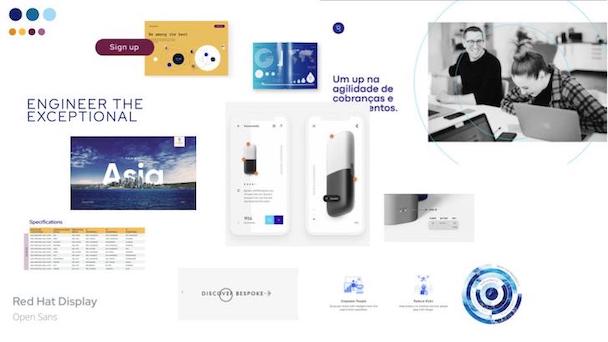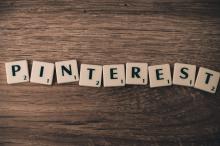



Why Your Brand Needs a Mood Board
Mood boards are the widely used, little understood tool of the branding process. You or your clients might have your research, personas, values and mission statements and think you’re ready to start creating logos, building websites and going full force to market. But not so fast. Overlooking the mood board is a critical misstep, and even though you might be ready to go, a mood board is the essential first step in bringing everything together to help clients realize their vision in something tangible.

What is a Mood Board?
Mood boards exist to help us align on a direction for design. They are a collection of borrowed design elements (fonts, color palettes, photo and icon styles, web UI screen grabs) that establish a preliminary look and feel. Each mood board should evoke a different feeling and personality, capturing one or more of the brand values. There is no right or wrong direction in picking one.
Types of Mood Boards
When it comes to branding, there are two principal mood boards: brand and web. Brand mood boards set the course for the entire brand experience. Web mood boards are more focused on a website’s UI elements. Brand mood boards define the look and feel of the company. Web mood boards reflect how people should feel when they visit a website. They are like brand mood boards, but they include more website elements such as buttons, screenshots, and image treatments.

What Makes a Good Mood Board?
A mood board can have multiple different elements, but there are some guidelines you can use to ensure your mood board hits the target:
- Balance: too much imagery is overwhelming, too little won’t provide direction
- Target: whether it’s the marketing team or the C suite, keep the audience in mind
- Visuals: colors, artwork, images, fonts — anything that conveys
- Consistency: stay focused
Even though it might seem like it, building a strong, unique brand doesn’t just happen overnight. Mood boards are a great way to temperature check what the client actually wants. Up to this point, it’s all very abstract. This is the first step in creating a vision and direction for a brand.
Mood boards inform brand guidelines and are an efficient way to get stakeholder buy-in without spending hours of design time. They help to refine the client’s visions and goals and can serve as the foundation for the guidelines that will serve as the source of truth.
Tip: We usually present two mood boards to a client. They are intentionally different with some focusing more on an evolution of the current brand where the other might be more of a revolution. This helps clients determine if they are still wedded to their current brand or looking for something more radical.

Creates Intention
Instead of spending time deliberating over the type of look a certain print ad should have, the mood board helps to guide the process, getting your message to market faster. Before any direction is finalized, the mood board organizes and presents options.
Provides Direction
Individual elements on a mood board are not to be taken super literally as a conclusive design decision, but they should be looked at holistically for the feeling and "vibe" they are giving off — personality and emotion are a big part of their purpose. Mood boards are an avenue to go down, not an exact address. They can be refined and elaborated on in print and digital marketing collateral. They can be a source of inspiration and reference when putting together and finalizing the brand guidelines.
Even though it might seem like it, building a strong, unique brand doesn’t just happen overnight. Mood boards are a great way to temperature check what the client actually wants. Up to this point, it’s all very abstract. This is the first step in creating a vision and direction for a brand.
Mood boards inform brand guidelines and are an efficient way to get stakeholder buy-in without spending hours of design time. They help to refine the client’s visions and goals and can serve as the foundation for the guidelines that will serve as the source of truth.
Tip: We usually present two mood boards to a client. They are intentionally different with some focusing more on an evolution of the current brand where the other might be more of a revolution. This helps clients determine if they are still wedded to their current brand or looking for something more radical.

Creates Intention
Instead of spending time deliberating over the type of look a certain print ad should have, the mood board helps to guide the process, getting your message to market faster. Before any direction is finalized, the mood board organizes and presents options.
Provides Direction
Individual elements on a mood board are not to be taken super literally as a conclusive design decision, but they should be looked at holistically for the feeling and "vibe" they are giving off — personality and emotion are a big part of their purpose. Mood boards are an avenue to go down, not an exact address. They can be refined and elaborated on in print and digital marketing collateral. They can be a source of inspiration and reference when putting together and finalizing the brand guidelines.
Archive
- April 2022 (1)
- February 2022 (1)
- January 2022 (1)
- December 2021 (1)
- October 2021 (1)
- June 2020 (1)
- July 2019 (1)
- April 2019 (1)
- March 2019 (1)
- February 2019 (2)
- December 2018 (1)
- July 2018 (1)
- April 2018 (7)
- August 2017 (1)
- July 2017 (2)
- January 2017 (1)
- December 2016 (1)
- August 2016 (1)
- October 2015 (1)
- September 2015 (1)
- June 2015 (2)
- May 2015 (1)
- February 2015 (2)
- December 2014 (1)
- November 2014 (1)
- October 2014 (1)
- April 2014 (4)
- February 2014 (1)
- December 2013 (1)
- October 2013 (2)
- September 2013 (1)
- July 2013 (2)
- June 2013 (1)
- April 2013 (2)
- March 2013 (2)
- February 2013 (1)
- January 2013 (1)
- December 2012 (1)
- October 2012 (2)


